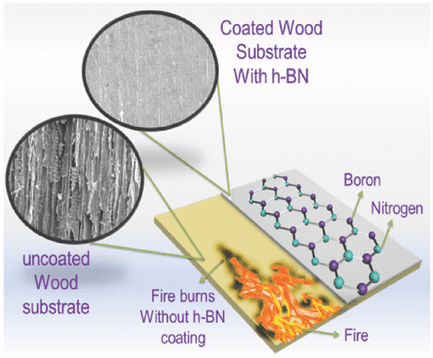Wood is one of the most traditional building materials, and still one of the most popular. However, natural wood can have unsafe flammability levels, requiring fire-resistant coatings to be added. These coatings can also include extra benefits such as water resistance, UV protection, and increased durability; however several current fire resistant coatings contain toxic and unstable compounds. In a new study in Small, researchers from China and Singapore present a new high performance, fire-resistant coating composed of hexagonal boron nitride nanosheets.
Hexagonal boron nitride (h-Bn) is already used as a coating for metal and metal oxide surfaces, and in this new study its use is extended to wood for the first time, mitigating many of the problems of traditional coatings. Current fire resistant coatings, in addition to their undesirable compounds, also require additional binding materials to attach to the surface of the wood, reducing their mechanical stability and lifetime, a problem not encountered by the nanosheets. h-Bn nanosheets were attached to a substrate of cedar wood and then tested by applying heat with a lighter. In the figure below the left side of the wood (lighter coloured) has been coated, and the right side has not. The coated portion clearly resists the applied heat much more effectively than the uncoated portion, which shows charring.

Oxidation resistance experiments were also carried out using a chemical vapour deposition furnace system, which showed the coating to be effective at resisting heat up to 900 °C. The good performance of the h-Bn nanosheets can be attributed to their anisotropic thermal conductivity: the nanosheets have a high thermal conductivity in-plane, but lower thermal conductivity perpendicular to the plane. This slows the transmittance of heat through the material, and protects the wood beneath.

















